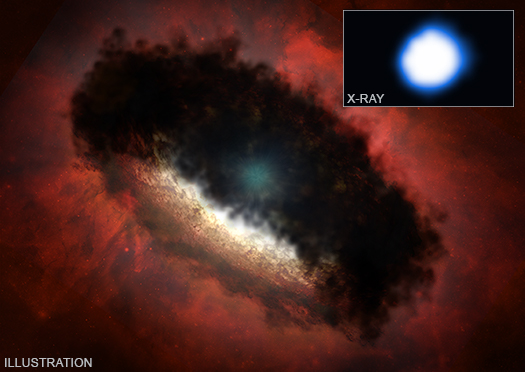For Release: June 18, 2020
NASA/CXC

X-ray: NASA/CXC/Aix-Marseille University/N. Grosso et al.; Illustration: NASA/CXC/M. Weiss
Press Image, Caption, and Videos
Astronomers have reported the first detection of X-rays from the earliest phase of evolution of a star like our Sun. This discovery, made using NASA's Chandra X-ray Observatory, may help answer some questions about the Sun and the Solar System as they are today.
The X-rays came from a flare emitted by an object called HOPS 383, located about 1,400 light years from Earth in the star-forming region of the Orion Molecular Cloud Complex. Astronomers refer to HOPS 383 as a young "protostar" because it is in the earliest phase of stellar evolution that occurs right after a large cloud of gas and dust has started to collapse. Once it has matured HOPS 383 will have a mass about half that of the Sun.
This result is significant because it resets the timeline for when astronomers think Sun-like stars start blasting X-rays into space. While scientists know that young stars are much more active in X-rays than older ones, they have debated just when X-ray emission begins.
"We don't have a time machine that lets us directly observe our Sun as it was beginning its life, but the next best thing is to look at analogs of it like HOPS 383," said lead author Nicolas Grosso of Astrophysics Laboratory of Marseille at Aix-Marseille University in France. "From these, we can reconstruct important parts of our own Solar System's past."
Chandra observations in December 2017 revealed the X-ray flare in HOPS 383, which lasted for about 3 hours and 20 minutes. No X-rays were detected from the protostar outside this flaring period, implying that during these times HOPS 383 was at least ten times fainter, on average, than the flare at its maximum. It is also 2,000 times more powerful than the brightest X-ray flare observed from the Sun, a middle-aged star of relatively low mass.
During the earliest stages of evolution of protostars — as represented by objects like HOPS 383 — about half of the protostar's mass likely still resides in a cocoon of dust and gas that is falling onto a disk surrounding the central star. Light from the infant star in HOPS 383 must pierce through this cocoon. Fortunately, X-rays are powerful enough to do just that.
As material from the cocoon falls inward toward the disk, there is also an exodus of gas and dust. This "outflow" removes angular momentum from the system, allowing material to fall from the disk onto the growing young protostar. Astronomers have seen a such outflow from HOPS 383 and think powerful X-ray flares like the one observed by Chandra could strip electrons from atoms at the base of it. This may be important for driving the outflow by magnetic forces.
"If this connection between X-ray flares and outflows is correct, similar flares may have played an important role in forming our life-giving host star, the Sun", said co-author Kenji Hamaguchi of Center for Research and Exploration in Space Science & Technology and NASA's Goddard Space Flight Center in Greenbelt, MD.
Furthermore, when the star erupted in X-rays, it would have also likely driven energetic flows of particles that collided with dust grains located at the inner edge of the disk of material swirling around the protostar. Assuming something similar happened in our Sun, the nuclear reactions caused by this collision could explain unusual abundances of elements in certain types of meteorites found on Earth.
"What the Sun did over 4.5 billion years ago affected the raw material that ended up making the planets and everything else in our Solar System," said co-author David Principe of the Massachusetts Institute of Technology in Cambridge. "Any X-rays from a young Sun may have played a big role in shaping those ingredients."
No other flares from HOPS 383 were detected over the course of three Chandra observations with a total exposure of just under a day. Astronomers will need longer X-ray observations to determine how frequent such flares are during this very early phase of development for stars like our Sun.
"How common are X-ray flares from the youngest protostars and how much of an influence do they have on the development of solar systems?" asked co-author Joel Kastner of the Rochester Institute of Technology in New York. "Only more observations can answer these important questions."
A paper describing these results appeared in the journal of Astronomy & Astrophysics and is available online at https://arxiv.org/abs/2006.02676
NASA's Marshall Space Flight Center manages the Chandra program. The Smithsonian Astrophysical Observatory's Chandra X-ray Center controls science and flight operations from Cambridge and Burlington, Massachusetts.
Other materials about the findings are available at:
http://chandra.si.edu
For more Chandra images, multimedia and related materials, visit:
http://www.nasa.gov/chandra
Media contacts:
Molly Porter
NASA Marshall Space Flight Center, Huntsville, Ala.
256-424-5158
molly.a.porter@nasa.gov
Megan Watzke
Chandra X-ray Center, Cambridge, Mass.
617-496-7998
mwatzke@cfa.harvard.edu


